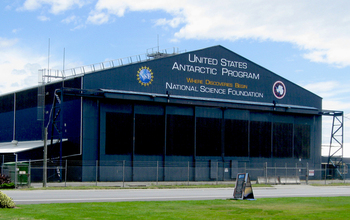News Release 16-148
Plane carrying Buzz Aldrin lands in New Zealand
NSF evacuated one of the first men to walk on the moon from its Amundsen-Scott South Pole Station

The U.S. Antarctic Program's hangar at the Christchurch, N.Z., International Airport.
December 1, 2016
This material is available primarily for archival purposes. Telephone numbers or other contact information may be out of date; please see current contact information at media contacts.
The plane carrying Buzz Aldrin out of Antarctica has reached Christchurch, New Zealand.
A Safair cargo aircraft touched down at Christchurch International Airport at approximately 4:25 a.m. (local time) on Dec. 2.
Aldrin was one of the two men who first walked on the lunar surface as part of the Apollo 11 lunar mission.
The National Science Foundation (NSF) agreed to provide a humanitarian medical-evacuation flight for Aldrin from its Amundsen-Scott South Pole Station to McMurdo Station on the Antarctic coast and then to New Zealand.
The request to NSF, which manages the U.S. Antarctic Program, came on Dec. 1 (local time, U.S. stations in Antarctica keep New Zealand time) from White Desert, a private tourism firm with whom Aldrin was traveling.
Ski-equipped LC-130 cargo planes flown by the 109th Airlift Wing of the New York Air National Guard provide the air bridge between the South Pole and McMurdo. Aldrin transferred to the Safair flight in McMurdo.
Upon arrival in Christchurch, the Antarctic program's logistics hub in New Zealand, Aldrin was transferred to a local medical facility.
There will be no further NSF updates.
-NSF-
Media Contacts
Peter West, NSF, (703) 292-7530, email: pwest@nsf.gov
The U.S. National Science Foundation propels the nation forward by advancing fundamental research in all fields of science and engineering. NSF supports research and people by providing facilities, instruments and funding to support their ingenuity and sustain the U.S. as a global leader in research and innovation. With a fiscal year 2023 budget of $9.5 billion, NSF funds reach all 50 states through grants to nearly 2,000 colleges, universities and institutions. Each year, NSF receives more than 40,000 competitive proposals and makes about 11,000 new awards. Those awards include support for cooperative research with industry, Arctic and Antarctic research and operations, and U.S. participation in international scientific efforts.
Connect with us online
NSF website: nsf.gov
NSF News: nsf.gov/news
For News Media: nsf.gov/news/newsroom
Statistics: nsf.gov/statistics/
Awards database: nsf.gov/awardsearch/
Follow us on social
Twitter: twitter.com/NSF
Facebook: facebook.com/US.NSF
Instagram: instagram.com/nsfgov


